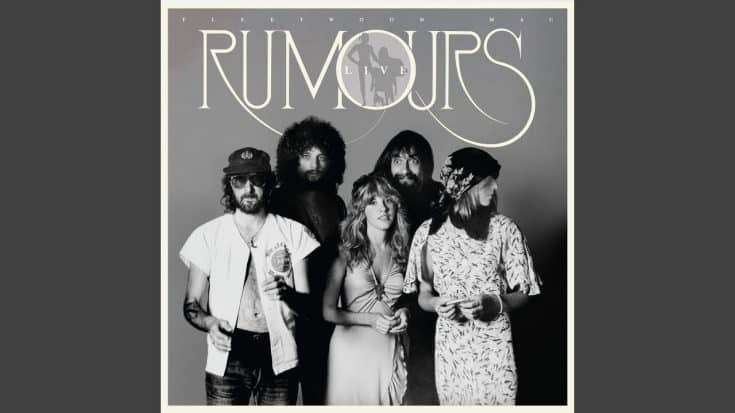The Stories Behind Every Song From Fleetwood Mac’s ‘Rumours’ As It Turns 48

via Fleetwood Mac / Youtube
Rumours, the legendary album by Fleetwood Mac from 1977, marked its 48th anniversary on February 4 and stands as a testament to the notion that creativity may come from adversity. The song was recorded during a time when the band’s two couples, Lindsey Buckingham and Stevie Nicks, Christine and John McVie, and drummer Mick Fleetwood, were divorcing. Despite all of the heartbreak, worry, and excess, they gave it their all to produce one of rock’s most iconic albums.
Christine McVie revealed in Classic Albums: Fleetwood Mac – Rumours, “We were all writing songs about each other, although we didn’t realize it at the time.” Named after their entwined tales, the record has sold 40 million copies since winning the 1978 Grammy for Record of the Year. Let’s now explore the incredibly intimate backstories of each song.
“Second Hand News”
In the Classic Albums documentary, Lindsey Buckingham disclosed that he always thought “Second Hand News” was a good option to open “Rumours.” The Bee Gees’ 1975 smash song “Jive Talkin'” serves as some inspiration for the song, which combines Scottish and Irish traditional elements with a lively, pop-driven energy.
Buckingham remembered, “I believe that when we first began cutting [the song], we were doing it as something that was a more literal translation [of Scottish and Irish folk].” Since it was going to be the first song and a pop album, we were also very concerned about preserving the pop qualities.
Fleetwood Mac decided to include “a dance beat within the confines” of that folk-inspired sound to make the opening of Rumours a powerful and uplifting start to the album.
“Dreams”
One of Stevie Nicks’ most iconic songs took shape when she slipped away from the main studio at the Record Plant and found inspiration in an empty hall once used by Sly Stone of Sly and the Family Stone.
“I knew when I wrote [‘Dreams’] that it was really really special,” Nicks shared in Classic Albums.
Eager to share it with the band, she also felt uneasy about how they might reshape her vision. “It’s always difficult to give your song to somebody and know that they’re going to take it places you can’t take it because they play guitar and piano and arrange music,” she admitted. “If they do a good job, then it’s great. If they don’t then it’s not great… Lindsey had an amazing way of taking my songs and making them wonderful when he was happy with me.”
Buckingham reflected on their musical connection, saying, “Whatever Stevie’s music was, somehow I was this soulmate who just knew exactly what to do with it. That never went away. It just became a little bittersweet.”
Dreams became Fleetwood Mac’s only Billboard No. 1 hit in June 1977 and reemerged in 2020 when Nathan Apodaca’s viral skateboard video introduced it to a new generation.
“Never Going Back Again”
Buckingham’s reflective ballad took shape “near the end” of Rumours as he came to terms with the fact that his romantic relationship with Nicks was beyond repair.
“I had met [another] young lady,” he shared in Classic Albums. “It didn’t turn into anything heavy but what it did do was put a little wind in my sails in terms of… having a regenerative spirit about things and being able to move on, which I hadn’t really been able to do for a little while.”
With its intricate fingerpicking and raw emotion, Never Going Back Again became a signature piece for Buckingham, frequently appearing in his solo performances and standing out as a powerful moment during Fleetwood Mac’s reunion tours.
“Don’t Stop”
Christine McVie’s uplifting anthem became one of Fleetwood Mac’s most enduring hits—and even served as Bill Clinton’s campaign theme during the 1992 election.
Originally titled Yesterday’s Gone, the song reflected McVie’s optimism for the future despite her recent breakup with bandmate John McVie. Surprisingly, John didn’t realize the song was about their split until years later.
“I never put that together. I’ve been playing it for years and it wasn’t until somebody told me, ‘Chris wrote that about you.’ Oh really?” he admitted in a 2015 interview.
Don’t Stop remains so deeply tied to Fleetwood Mac’s legacy that Buckingham and Christine chose not to perform it when they toured without the full band in 2017.
“Go Your Own Way”
Buckingham wrote Rumours’ most hard-hitting rock song as a way to process the emotional chaos within Fleetwood Mac.
While “Never Going Back Again” reflected on heartbreak with quiet acceptance, “Go Your Own Way” burned with frustration and defiance. “You had two couples breaking up in the process of making this album, so you had all this cross-dialogue going on,” Buckingham explained in 1993.
The song was “basically directed at Stevie,” he admitted, while Fleetwood called it “Stevie and Lindsey playing out whatever roles they were playing out.”
Nicks saw “Go Your Own Way” as Buckingham’s response to “Dreams”, noting, “‘Dreams’ was hopeful… unlike ‘Go Your Own Way,’ which was not hopeful that we would be OK.”
The song became Rumours’ first big hit, breaking into the Billboard Top 10 in March 1977.
“Songbird”
Christine McVie described writing “Songbird” as a deeply spiritual experience.
“That was a strange little baby, that one,” she told The Guardian in 2016. “I woke up in the middle of the night and the song just came into my head. I got out of bed, played it on the little piano I have in my room, and sang it with no tape recorder. I sang it from beginning to end: everything.”
At first, she hesitated to bring “Songbird” into the Rumours sessions, fearing she might lose its magic. “I was frightened to play it again in case I’d forgotten it,” she admitted. “Everyone just sat there and stared at me… I’ve never had that happen to me since.”
Producer Ken Caillat recalled hearing it for the first time: “Christine sat down at the piano and started playing this beautiful song. I stopped what I was doing… I was just amazed.”
“The Chain”
The tension within Fleetwood Mac came to a head in the opening drum beats of “The Chain,” a song that spoke to the band’s ability to overcome personal issues through their shared bond.
“It just all came out in the studio when we were recording. A lot of the emotion of those moments like that solo are very connected to what we were living,” Buckingham told Entertainment Weekly in 2021. “The thing about ‘The Chain’ is, yes, it’s a signature piece of ours, but it’s also the spirit of the song and the content lyrically is very much in keeping with the legacy we built over a long period of time of always being able to rise above the difficulties in order to fulfill a greater destiny, so there was always a chain.”
The song’s theme of unity made it the perfect choice for the opening of Fleetwood Mac’s 1997 reunion concert, The Dance.
“You Make Loving Fun”
While Buckingham and Nicks’ breakup played out openly during the Rumours sessions, Christine McVie was secretly dating Fleetwood Mac’s lighting director, Curry Grant, keeping it from her ex-husband John. Initially, Christine claimed “You Make Loving Fun” was about her dog, but she later revealed the truth in the Classic Albums documentary.
“That [song] was about my then-boyfriend, at the time,” McVie admitted. “For obvious reasons, since he was our lighting director, he was not welcome in the studio.”
Producer Richard Dashut mentioned that Christine had nearly completed the song in her mind before recording it. Buckingham believed “You Make Loving Fun” proved that despite their different musical backgrounds, he and McVie shared a common melodic sense. The track reached No. 9 on the Billboard chart when released as the final single from Rumours in September 1977.
“I Don’t Want to Know”
“I Don’t Want to Know” has a controversial spot on Rumours, replacing the eventual B-side “Silver Springs” despite Nicks’ protests. In a BBC documentary, Nicks recalled Fleetwood informing her that the band felt “Silver Springs” didn’t fit the album.
“They said there’s a lot of reasons, but basically it’s too long, and they thought another one of my songs was better,” Nicks explained. “Before I got upset, I asked, ‘What other song?’ and they said, ‘A song called ‘I Don’t Want To Know.’ I said, ‘But I don’t want that song on this record.’ And Fleetwood replied, ‘Well, then don’t sing it.’”
Originally recorded for their 1973 album, the song was revamped with McVie’s Wurlitzer electric piano, adding a vibrant country influence.
“Oh Daddy”
When Rumours was released, Christine McVie explained in interviews that “Oh Daddy” was inspired by Mick Fleetwood’s recent separation from his wife, Jenny Boyd.
Producer Ken Caillat shared in Making Rumours that Fleetwood saw the song as a “lesson in less is more.”
“It’s one of my favorite songs that Christine has ever written,” Fleetwood said. “I think it’s a fantastic song.”
“Oh Daddy” made a return to Fleetwood Mac’s live shows during their 1997 reunion tour, but it was eventually retired from performances in later years.
“Gold Dust Woman”
“Gold Dust Woman,” the final track of Rumours, stands as one of Stevie Nicks’ most haunting songs, reflecting the turmoil she was enduring—both in her relationships and with her struggles involving cocaine.
Nicks described the song as a symbolic portrayal of someone battling through a bad relationship while using drugs to cope. “It’s about trying to live, trying to get through it to the next thing,” she explained in the Classic Albums documentary.
Buckingham praised the track for giving the band a chance to “get a little looser, a little more abstract.” He added, “The song is very dark… I’m guessing that the acrimony was directed at me at the time.”
The song’s title references Gold Dust Lane in Wickenburg, Arizona, where Nicks spent her youth.
“Silver Springs”
Rumours almost had a different final track when “Silver Springs” was cut at the last minute in favor of “I Don’t Want to Know,” which Fleetwood Mac felt fit better with the rest of the album.
In a 1993 BBC documentary, Nicks recalled how devastated she was to lose “Silver Springs,” which she considered the best song she’d ever written. “I started to scream bloody murder… and probably said every horrible thing I could,” Nicks admitted. “I said, ‘I’m not gonna sing ‘I Don’t Want To Know.’ I am one-fifth of this band.’”
Eventually, “Silver Springs” was released as a B-side to “Go Your Own Way.” Nicks got the last word, performing it in a stunning moment during Fleetwood Mac’s 1997 reunion concert.






























